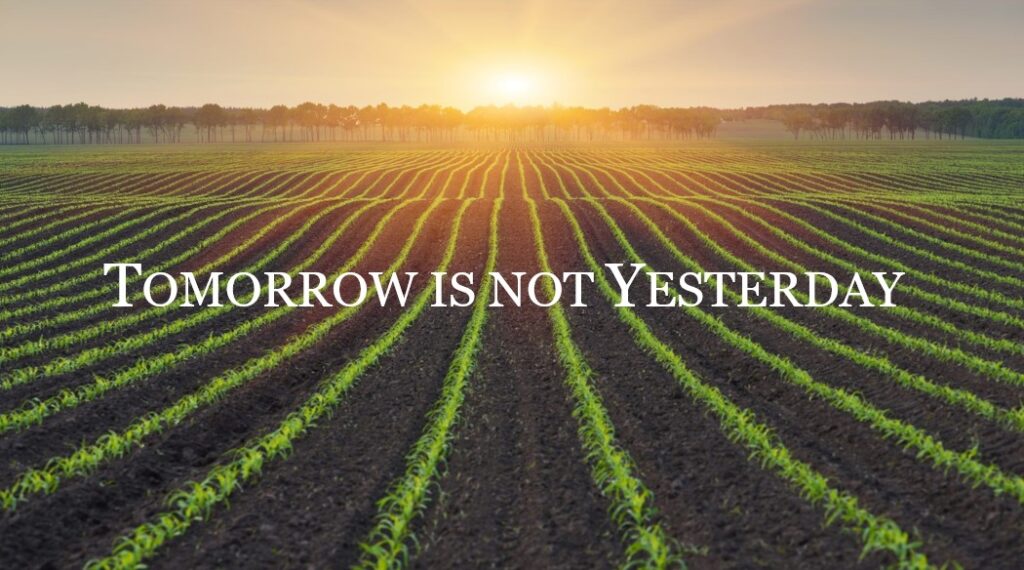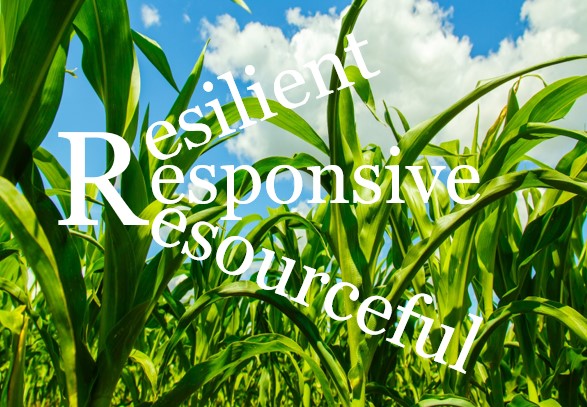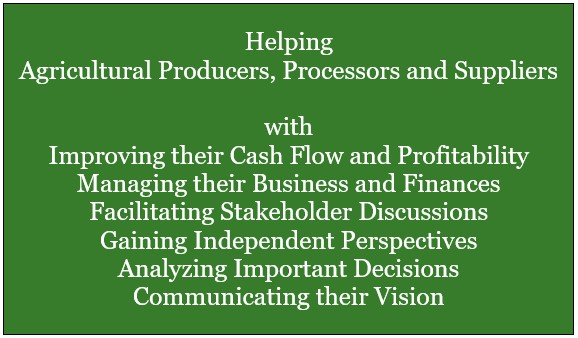If you are using Internet Explorer to view this site, please use another browser for optimal viewing.
Please share this page with these links to Facebook, Twitter, LinkedIn and Email:

Tomorrow is not yesterday. Change is constant. Everyone manages change. Many are managing reactively for yesterday instead of proactively for tomorrow. Covid-19 has increased the pace of change and the number of potential future scenarios. Our ability to manage change must increase as well.
Trying to manage increased change reactively isn’t nearly as effective and efficient as using proactive strategic planning to manage change. Strategic planning is more about being prepared for the possibilities of potential future scenarios rather than trying to guess which particular future scenario will play out. Not that a strategic plan is fully developed for each potential future scenario, but each scenario needs a plan.
These are concepts that were presented by Dr. Allan Gray, the Land O’Lakes Chair in Food and Agribusiness at the Purdue University Center for Food and Agricultural Business, during a recent webinar hosted by Indiana Soybean Alliance and Indiana Corn Growers which was sponsored by Bayer, First Farmers Bank and Trust, Co-Alliance and Farm Credit Mid-America.
Dr. Gray discussed big, broad drivers of change as well as important strategies to be resilient, responsive and resourceful. I will review each of these later in this article. There was one slide that Dr. Gray included in his presentation but skipped over in the essence of time. I think that slide (Slide 10) might have been the most important slide in the entire deck.

Agile Implementation
Slide 10 presented an approach to change management that can help managers actually strategically plan for and most importantly implement change. While understanding the drivers of change and the potential scenarios that they could create, as well as having strategies to deal with these potential scenarios, are important, they don’t create value if they aren’t implemented. Implementation is crucial and is usually the hardest part. Slide 10 introduces the concept of agile implementation.
Agile implementation is the process of having small self-organizing, cross-functional teams move fast delivering minimally viable results in short daily/weekly sprints which allow for continuous changes and improvements based on current needs and continuous collaboration with stakeholders that align with a broad, written vision.
This allows the team to manage an implementation by breaking it up into several stages where earlier stages can be tested, implemented and evaluated while the next stages and continuous improvements are being designed and tested. The goal is to deliver value to customers faster with fewer headaches by quickly responding to change with flexibility.
Change Management Team Structures
Slide 10 presented the following team structures needed to blend strategic scenario thinking with agile implementation.
Transformation Team – Strategic Planning Scenario Development
- Develop and analyze scenarios for multiple versions of the future – both positive and negative
- Define trigger point thresholds for each scenario where the design teams will start their agile process to develop changes that are needed
- Monitor environment to identify trigger points and add new or remove unneeded scenarios
- This team needs to know the business well enough to know what could go wrong and what could go right due to any number of internal or external factors
- This team can be a little larger since it needs to represent internal and external perspectives and won’t be meeting as frequently as the design team
Design Teams – Agile Design, Test, Pilot and Improve Process
- Identify the design teams needed for the changes contemplated with each of the potential scenarios
- Identify and prepare the internal and external resources needed for each team if they are triggered
- Design, test, pilot and improve new concepts and ideas in a collaborative environment with agile sprints once a strategic planning scenario is triggered
- These teams will favor action over research and testing over analysis to pilot concepts quickly when a scenario is triggered
- Members of these teams will need to make the frequent meetings of the team a top priority when triggered
Implementation Team – Implement Changes and Share Results
- Roll out changes to the entire organization that have already been piloted successfully in a part of the business by the design team
- Document procedures and train employees to implement changes
- Gather and evaluate results and feedback for the transformation and design teams
- Set expectations for bold moves, “no regret” actions and changes that might not be the ultimate solution, but they are a start and are expected to be improved based on feedback, priorities and results.
By preparing ahead of time for potential scenarios (transformation team) and having resources identified and ready when needed to create and test new concepts (design team), the implementation team has a better chance of delivering a successful, quick and valuable change solution to the customer. The keys to success for this process include obtaining stakeholder buy-in, starting with small projects, focusing on tactical actions that can be accomplished over short periods, empowering and motivating the teams, assessing what is and isn’t working, being open to improvements and changes, collaborating and communicating frequently, and making changes as needed.

Important Strategies to be
Resilient, Responsive and Resourceful
- Start-up mindset
- Action over research and testing over analysis
- Efficiency, cost and value creation focus
- Human at the core
- Operate based on how people work best
- Maximize people engaging with each other
- Acceleration of digital, tech and analytics
- Combine new sources of data
- Make better and faster decisions
- Strengthen customer relationships
- Purpose-driven customer playbook
- Understand what customers will value
- Develop new use cases and tailored experiences
- Ecosystems and adaptability
- Non-traditional collaborations within the supply chain

Big Broad Drivers of Change
1. Deglobalization
- Protectionism and restrictive attitudes
- 3 of 7 billion people are in closed-border countries
- Local > Global
- Supply chains sourcing closer to end markets
- Smaller production capacity and less efficient plants
- Increased costs will not be affordable for those at the margin
2. Resilience versus Efficiency
- Resilience: Ability to absorb a shock and come out of it better than the competition
- Anti-fragile: Ability to absorb a shock and come out of it better than before
- Preparation: Must be able to decrease cost per unit of production – increase production and decrease costs
- Is government aid reducing the drive to decrease costs?
- May need to restructure supply chain while balancing costs, sales and risks
- Resiliency is just as important to strategic thinking as cost and efficiency
3. Contact-Free Economy
- Digital commerce – buying and selling on-line
- Videomedicine, Videoselling, Videolearning, Videomanaging
- Automation developed for one industry and adapted for others
4. More Government Intervention
- During times of great crisis citizens have proved willing to accept greater government control of the economy
- As interventions are more common, the implications for the role of the state will materially affect the way business is conducted – strings attached to the money
- Continuous support from the government is limiting improvements in cost of production due to businesses not seeing the downside risk necessary for investment in new technologies
5. More Business Scrutiny
- Shareholder value is not the only corporate value
- People, planet, profit
- Social features, environmental stewardship, labor relations, financial responsibility and accountability
- With public money, scrutiny will intensify
6. Industry Structure Shifts
- Which supply chain is your business a part of
- What happens when there is a major shift in demand
- How can you switch and be more flexible
- Vulnerability where labor is most involved
- Increased automation, employment shifts
7. Employment Shifts
- Dramatic unemployment – what will be the long-term impacts
- Enormous increases in the generosity of the welfare state
- Large supply of workers may lower average wages
- Unemployment problematic for less-educated essential workers
- Might be easier to find skilled workers
- Immigration issues if we need jobs for US citizens
- Labor mobility to certain jobs doesn’t exist
8. Silver Linings
- Individuals, communities, businesses and governments alike are all learning new ways to connect
- Better management and more flexible workforces
- Pace and scale of innovation is increasing
- Virtual learning and productivity
How can AgriStrategies LLC help?

